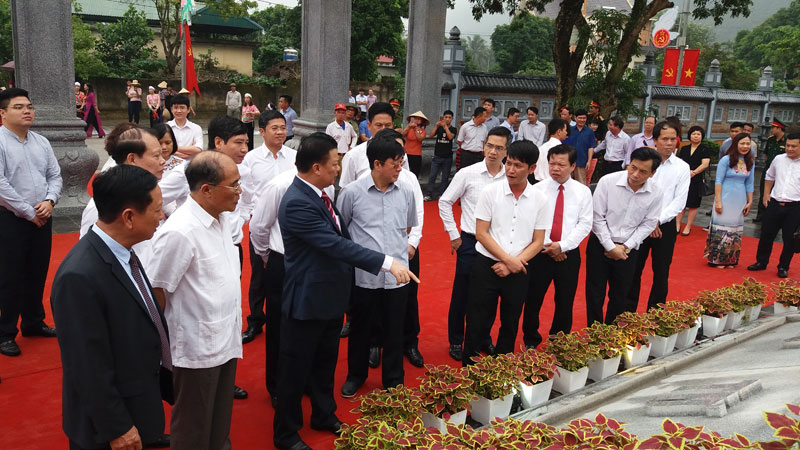
(HBO) - A commemorative house dedicated to contributors to and workers of the first money printing factory of Vietnam was inaugurated on May 5 in Co Nghia commune of Lac Thuy district, Hoa Binh province.
The
inauguration ceremony was attended by former Politburo member, former National
Assembly Chairman and former Minister of Finance Nguyen Sinh Hung; member of
the Party Central Committee and Minister of Finance Dinh Tien Dung; and member
of the Party Central Committee and Secretary of the provincial Hoa Binh Party
Committee Bui Van Tinh.
 Former
Party and State leaders and officials of the Finance Ministry and Hoa Binh
province visit the commemorative house.
Former
Party and State leaders and officials of the Finance Ministry and Hoa Binh
province visit the commemorative house.
The relic site in Chi Ne Farm in Co Nghia
commune was the first money printing factory of the Democratic Republic of
Vietnam, now the Socialist Republic of Vietnam. There, the 100 VND or "green
buffalo” notes – the banknote with the highest face value at that time – along
with the notes valued at 50 VND, 20 VND, 5 VND and 1 VND of Vietnam’s
revolutionary government were issued, holding a significant role in the first
years of the country’s independence.
In 1947, President Ho Chi Minh visited the
factory, which has become an important revolutionary relic site of Hoa Binh
province as well as Vietnam.
To honour contributors to the factory, the Lac
Thuy District People’s Committee built the commemorative house. The
construction cost some 50 billion VND (2.1 million USD), 80 percent of which
was supported by the Finance Ministry and the State Treasury and the remaining
was funded by the local budget.
Addressing the inauguration ceremony, Minister
of Finance Dinh Tien Dung highlighted the significance of the "green buffalo”
note, which was a weapon in the economic-financial-monetary battlefield to
eliminate the Indochinese banknotes of the French colonialists in Vietnam.
He asked party committees, authorities and
people of Hoa Binh province and Lac Thuy district to create more favourable conditions
for promoting historical values of this relic site so that it can become a
pride of the revolutionary tradition.
Meanwhile, Secretary of the provincial Party
Committee Bui Van Tinh thanked ministries, central agencies, businesses, donors,
and local people for supporting the construction of the commemorative house.
He also told local authorities and people to
bring into play the relic’s values, popularise its historical values, and
connect this relic with others in neighbouring localities to form cultural and
historical tours, thereby helping to enhance local development./.
The Standing Board of the Hoa Binh provincial Party Committee has agreed in principle on a proposal by the Standing Board of the Party Committee of Hoa Binh city to gather feedback on the city’s 1:2000 zoning plan, which forms part of its broader urban development strategy.
Hoa Binh province has made notable progress in public administration reform and digital government development, with the satisfaction index among citizens and businesses reaching over 84%, according to recent government evaluations.
Thanks to great efforts by local authorities in recent times, the governance and public administration performance of Mai Chau district has been significantly improved.
In the afternoon of June 6, the Party Committee, the People's Council, the People's Committee and the Fatherland Front of Lac Son district solemnly held a meeting to celebrate the 139th anniversary of the district's founding (1886–2025) and the 79th anniversary of the establishment of the district's Party Committee (1946–2025). There was the attendance of Mr. Bui Van Thang, the Vice Chairman of the Provincial People's Council; Mr. Quach Tat Liem, the Vice Chairman of the Provincial People's Committee; Ms. Dang Bich Ngoc, the Deputy Head of the National Assembly Delegation of the province; as well as the former leaders of the province and district through various periods, who are the natives of the district.
Implementing the Politburo’s Resolution No. 57-NQ/TW on breakthroughs in science – technology, innovation, and digital transformation is a golden opportunity for the northern mountainous province of Hoa Binh to renew growth model, improve competitive edge and shorten digital gap.
Resolution 57-NQ/TW, issued by the Politburo on December 22, 2024, identifies sci-tech, innovation, and digital transformation as strategic breakthroughs to build a developed and prosperous nation. In Hoa Binh province, this spirit is not just a slogan, it’s being put into action through concrete initiatives that form a "new development triangle”: digital citizenship, digital economy, and digital administration.



 Former
Party and State leaders and officials of the Finance Ministry and Hoa Binh
province visit the commemorative house.
Former
Party and State leaders and officials of the Finance Ministry and Hoa Binh
province visit the commemorative house.